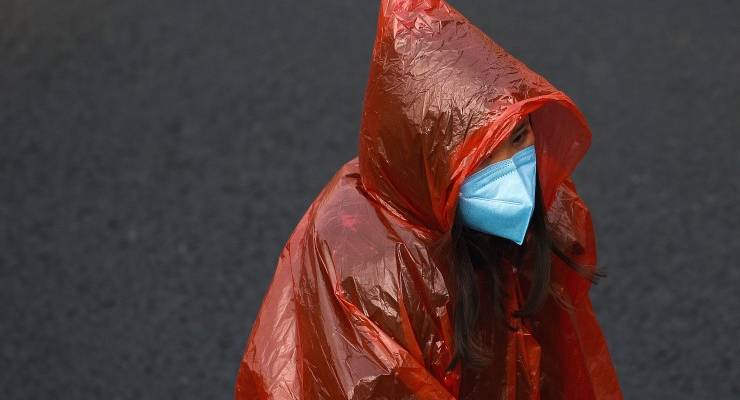
A serious COVID-19 outbreak in China’s north-east has seen new infections suddenly soar close to the 1000 mark, jolting the country’s government into action.
It’s the first sign that the Communist Party’s assumed control of the disease (and growing hubris) may have been misplaced — at least for now.
It comes less than a week after Chinese authorities finally added to Wuhan’s death toll, increasing it by an alarmingly neat 50% to 3869.
This has been seen as an effort to placate world governments and observers across the globe who have been struggling to believe the numbers the ruling Communist Party was originally producing — particularly given reports of tens of thousands of funeral urns sent to the original epicentre in Wuhan.
The new COVID-19 hotspot is around the far flung city of Harbin, capital of Heilongjiang province, which is home 38 million people and shares a lengthy border with the Russian Federation.
With a population of 10 million, Harbin is famous for its ice festival held in the depth of a frigid winter where temperatures in January reach average lows of -23 Celcius.
The rise in cases has been attributed to locals returning from Russia, with dozens of people on incoming planes being identified and put under medical care.
Wary of another Wuhan, lockdown and quarantine rules introduced earlier this month have been some of the harshest and most stringent in the world: a full 28 days of quarantine for all arrivals from abroad, who must then submit for two nucleic acid tests and an antibody each.
For residences where any confirmed or asymptomatic cases are found, a 14-day lockdown has been imposed. These were strengthened mid week with non-locals or non-locally registered vehicles banned from entering the city.
According to a new study published in The Lancet by academics at Hong Kong University’s School of Public Health, China seems to have undercooked its COVID numbers by 75%.
It estimates that more than 232,000 people may have been infected in the first wave of COVID-19, while the Chinese government reported fewer than 56,000 cases as of February 20. The paper puts the discrepancy down to fast-changing definition of cases, and estimates previous numbers using the current definition.
The Harbin spike carries a number of warnings against complacency, porous borders and the perils of plane travel as well as the power of one person to trigger an outbreak. A Reuters report identified a lone, 87-year-old man who had infected 78 people, including family members, hospital patients and their families, and doctors and nurses in direct or indirect contact.
The spike has cast doubts over the veracity of Russia’s figures — officially 57,000 with only 513 deaths — amid fears a potentially unreported catastrophe may be playing out.
There are lessons for Australia (and elsewhere) in the emergence of a new COVID-19 hotspot in China, representing a so-called second wave of the disease — something already predicted by virologists.
In addition to China, Singapore — previously feted for its swift action and control of the disease — has seen a second wave of infections in the past week. The culprit: cramped and poor-quality dormitories for migrant workers, mainly for males from India and Sri Lanka where there has been a surge in infections.
Even more problematically, tracing had proven difficult and at times impossible. Two weeks ago Singapore had fewer cases than Australia. As of April 24, it had 11,178 confirmed cases compared to Australia’s 6661, but with only 12 deaths compared with 76 in Australia.
Like the Russian border was for China, the migrant worker’s dormitories were a “blind spot” for Singapore’s government.
Still, Singapore has also delivered a humanitarian lesson for similarly wealthy Australia. Here, trapped migrant workers, backpackers and international students who have lost work have been left out from the Morrison government’s bumper safety-net package, told to “go home” if they cannot support themselves.
Meanwhile, Singapore PM Lee Hsien Loong said that foreign workers will be taken care of. “We will look after your health, your welfare and your livelihood,” he said.
That advocating of human rights is overdue as the situation in Singapore has shone a harsh light in the way the city-state treats its poorly paid migrant workers, who are so dismissed that authorities could not perceive their harsh living conditions as a virus threat.








This virus pandemic has made me realise that about half the world’s population (and probably 90% of its bureaucracy) goes around with it’s head up it’s a—se or in the clouds and not wanting to see inconvenient truths. How could anyone with even half a brain think that living in close contact in squalid conditions was not a vector for spreading diseases not just this corona virus
It would be cheaper to support the migrant workers, backpackers and international students than to deal with a succession of virus hotspots. The too expensive, have to draw the line somewhere attitude of the gov’t may turn out to be false economy. The weak spots will eventually show up.
“We will look after your health, your welfare and your livelihood,” he said.
Talk is cheap. What has he actually done for them?
This is much more balanced reporting on China and the pandemic than we’ve had before from Michael Sainsbury. China’s official figures on cases and deaths have been revised up but, apart from Trump and right wing organisations around the world, we have no wild accusations about China and a China controlled WHO being responsible for cases in the rest of the world. Other nations are responsible for what happens in their countries and we have seen a range of outcomes, depending on what has happened in those countries and what their governments have done, ranging from pretty hopeless in the US-does any other country have a leader who wonders out loud whether injections of disinfectant might help??!!-through bad in the UK, Spain and Italy to good in South Korea and better still in the naturally isolated Islands of Australia and New Zealand. In the light of revisions to death counts in the UK and the US, we gratefully don’t need to treat the increase in deaths counted or Even increases in cases in China as sinister but only as evidence of changes in methodology and the overwhelming speed of the pandemic. The 50% increase in Wuhan’s death indicates only that they do not have complete confidence in their count, although China’s count is probably much more accurate than the count in Indonesia and other countries. The anti-Chinese aroma around the reporting remains, since the Ethnically Chinese government in Singapore has got a new outbreak from foreign workers, who have been in confined quarters. Yes, this is deplorable mistreatment but just think about the outbreak in immigration detention in the US, where immigrants are deported with frightening rates of infection from US detention centres. That mistreatment is appalling too.
I’m still waiting for the admission that lockdown, delaying the inevitable, is not a solution.
No matter how long – talk of a year is now becoming common in the UK amongst the bien pissant who needn’t worry whence their next properly chilled flute of champagne comes – when. not if, life begins to re-emerge, blinking into the sunlight, so will the virus.
Face it, this is the new old norm, when blythe insouciance in the face of sudden illness & early death was as normal as beggars in the street and homeless under bridges and… oh, wait.
Sorry, as you were.